Effect of tillage practices and moisture regimes on the performance of growth, yield and nutrient uptake of timely sown wheat (Triticum aestivum L.)
Bạn đang xem bản rút gọn của tài liệu. Xem và tải ngay bản đầy đủ của tài liệu tại đây (257.86 KB, 8 trang )
Int.J.Curr.Microbiol.App.Sci (2019) 8(3): 2368-2375
International Journal of Current Microbiology and Applied Sciences
ISSN: 2319-7706 Volume 8 Number 03 (2019)
Journal homepage:
Original Research Article
/>
Effect of Tillage Practices and Moisture Regimes on the Performance of
Growth, Yield and Nutrient Uptake of Timely Sown Wheat
(Triticum aestivum L.)
Vinay Kumar Pandey*, B.N. Singh, Manoj Kumar, Shrimannarayan Dubey,
Vipul Singh, Deepak Pandey and Ajit Kumar
Department of Agronomy, Narendra Deva University of Agricultural & Technology,
Kumarganj, Faizabad, Uttar Pradesh-224229, India
*Corresponding author
ABSTRACT
Keywords
Tillage practices,
Moisture regimes,
Growth, Yield,
Nutrient uptake
Article Info
Accepted:
20 February 2019
Available Online:
10 March 2019
The experiment was conducted during rabi season 2015-16 and 2016-17. The present
investigation entitled “Effect of Tillage Practices and Moisture Regimes on the
Performance of Wheat” was conducted at Agronomy Research Farm, of Narendra Deva
University of Agriculture and Technology, Narendra Nagar (Kumarganj) Faizabad (U.P.).
The experiment was laid out in split plot design having four tillage practices (zero tillage,
reduced tillage+sowing by seed cum ferti drill, conventional tillage+sowing on beds and
conventional tillage+ sowing by seed cum ferti drill) as main plot treatments and five
moisture regimes (irrigation at 0.8 IW/CPE, irrigation at 1.0 IW/CPE and irrigation at 1.2
IW/CPE irrigation at 3 Irrigation each at CRI, Late jointing and Milking stage and 5
Irrigation each at CRI, Tillering, Late jointing, Flowering and Milking stage) as sub plot
treatments. 20 treatment combinations were replicated three times. The result revealed that
the growth, yield and nutrient uptake were recorded significantly higher in conventional
tillage + sowing on bed, which was at par with conventional tillage+ sowing by seed cum
ferti drill during both the years due to performance of tillage practices. However, the
growth, yield and nutrient uptake were significantly higher under irrigation at 1.0 IW/CPE
being at par with 1.2 IW/CPE ratio and 5 Irrigation each at CRI, tillering, late jointing,
flowering and milking stage over rest of the treatments causes optimum availability of
moisture at critical stage of the crop growth.
Introduction
Wheat (Triticum aestivum L.) is one of the
most important cereal crop belong to the
family Poaceae, in the world. In India wheat is
the second most important food crop next to
rice and it contributes nearly 35% to the
national food basket. Among winter crops, it
contributes about 49% of the food grains. In
India, total area under wheat is 31.72 m ha
with the production and productivity of 96.0 m
tonnes and 3.13 tonnes ha-1, respectively. It
ranks first in the world among the cereals both
in respect of area (225.07 m ha) and
2368
Int.J.Curr.Microbiol.App.Sci (2019) 8(3): 2368-2375
production (736.98 mt) (USDA, 2017). In
India, total production of wheat crop was
86.53 mt from an covered area of 30.23 m ha
during the recent past 2015-16 Rabi season
and accounts for 38 per cent 4th Advance
Estimates. (Directorate of Economics and
Statistics, Ministry of agriculture and farmers
Welfare, India, 2016).Major wheat producing
countries in the world are China, India USA,
France, Russia, Canada, Australia, Pakistan,
Turkey, UK, Argentina, Iran and Italy. These
countries contribute about 76% of the total
world wheat production. As far India is
concerned, about 91% of the total wheat
production is contributed by northern states. In
India, the state wise production tops with of
the Uttar Pradesh 26.87 mt, followed by
Madhya Pradesh 17.69 mt, Punjab 16.08 mt,
Haryana 11.35 mt, Rajasthan 9.87 mt, and
Bihar 4.75 mt. These top six states together
contributed about 93 per cent of the total
wheat production.
Tillage is practiced in soils for controlling
weeds, breaking crusts (improving water
entry), increasing surface roughness (assisting
water storage) and preparing a seedbed. The
type of tillage method to be practiced,
however, depends upon the soil type and the
climate of the area (Coughlan et al., 1989).
Various techniques viz., zero-tillage (ZT) and
bed planting have proved to be beneficial in
terms of improving soil health, water use and
crop productivity (Anonymous, 1995). ZT is
widely adopted by farmers in the
Northwestern Indo-Gangetic plain of India,
particularly in areas where rice is harvested
late (Bhushan et al., 2007). It reduces
irrigation requirements compared with
conventional-tillage by using residual water
more effectively (Erenstein et al., 2007). Bed
planting, another RCT, has benefits like
reduced seed rate, rainwater conservation,
mechanical weeding and less crop lodging
(Gupta and Seth, 2007). Water is an important
input for realizing high wheat productivity;
however, it is becoming the most limiting
factor for crop production in most of the north
western parts of India (Hira, 2009). Irrigation
water is a major constraint for assumed crop
production. To grow wheat economically and
successfully the evapo-transpirative demand
must be balanced with supply of available to
it. Proper scheduling of irrigation (amount and
timing) is an important component of water
saving techniques. There are numerous ways
to schedule irrigations and estimate the
required depth of water application Prihar et
al., 1997).
Materials and Methods
The present investigation entitled “Effect of
Tillage Practices and Moisture Regimes on the
Performance of Wheat” was carried at
Agronomy Research Farm, of Narendra Deva
University of Agriculture and Technology,
Narendra Nagar Kumarganj, Faizabad (U.P.)
out of during Rabi season, 2015-2016 and
2016-17. The experiment was constituted with
20 treatment involving four tillage practices in
main plot and five irrigation levels in sub plot
was laid out in split plot design with three
replications. The experiment was laid out in
given following viz., tillage practices mention
are:
T1-Zero
tillage,
T2-Reduced
tillage+sowing by seed cum ferti drill, T3Conventional tillage+ sowing on beds and T4Conventional tillage+ sowing by seed cum
ferti drill as main plot treatment and five
irrigation levels I1-Irrigation at 0.8 IW/CPE,
I2-Irrigation at 1.0 IW/CPE, I3-Irrigation at 1.2
IW/CPE, I4-Irrigation each at CRI, Late
jointing and Milking stage and I5-5 Irrigation
each at CRI, Tillering, Late jointing,
Flowering and Milking stage as sub plot
treatment. Wheat was sown on 15th November
during in both years (2015-16 and 2016-17) at
with a row spacing of 20 cm with seed cum
ferti drill. Recommended dose of fertilizer
N:P:K 120:60:40 kg ha-1 gave in crop.
Uniform dose of nitrogen 60 kg ha-1 through
2369
Int.J.Curr.Microbiol.App.Sci (2019) 8(3): 2368-2375
urea, phosphorus @ 60 kg ha-1 through diammonium phosphate and potassium @ 40 kg
ha-1 through muriate of potash 60% (K2O)
were applied to all treatments as basal
dressing. Remaining half and 1/3 quantity of
nitrogen was top dressed at CRI and tillering
stage. Experimental field was slit loam in
texture with low organic carbon (0.381 0.
0.421 %), low nitrogen (160.27 and 165.53 kg
ha-1), and medium in phosphorus (16.83 and
17.78 kg ha-1) and high range in potassium
(258.57 and 265.27 kg ha-1).
The variety was sown PBW-502. Ii is widely
adopted in the area NWPZ. This variety may
be grown in Entire North East India of India.
It gives an average yield of 46-50 q ha-1.
Effective tillers were observed in running
meter, and then converted values in square
meter. The straw yield was computed by
deducting the grain yield from the total
biological yield and the grain yield data were
adjusted at 14% moisture content. Statistical
significance between mean differences among
the treatment for different parameter was
analyzed using the critical differences (CD) at
0.05 % probability level.
Results and Discussion
The experimental results presented in the
previous chapter contained the detailed
information on study entitled “Effect of
Tillage Practices and Moisture Regimes on the
Performance of Wheat.” to find out the
suitable tillage practice and moisture regime
for wheat production given following result
and discussion below:
Effect of tillage practices on growth and
yield
Initial plant population taken at 15 days after
sowing was not influenced due to tillage
practices. It was possibly due to favorable and
similar soil and moisture condition for
germination of seed in all treatments. This was
mainly due to the fact that initial plant
population was conducted at 15 DAS and
irrigation treatments were not applied up-to
this period.
Maximum initial plant population was
recorded 133.35 and 134.14 plants m-2 in
conventional tillage + sowing on beds (T3)
which was at par with conventional tillage+
sowing by seed cum ferti drill (T4) and
reduced tillage + sowing by seed cum ferti
drill (T2) respectively. Maximum plant height
(cm), number of shoots m-2 and dry matter
accumulation (gm m-2) at harvest stage
significant was recorded treatment under
conventional tillage + sowing on beds (T3)
which was at par with conventional tillage+
sowing by seed cum ferti drill (T4) and
reduced tillage + sowing by seed cum ferti
drill (T2) respectively, during both the years.
However, the lowest all the parameters were
recorded under treatments zero tillage (T1)
(Khatri et al., 2002; Ishaq and Ibrahim, 2003;
and Naresh et al., 2012). Number of shoots m2
were not affected significantly due to
different tillage practices at all the stages of
crop growth. It increased progressively up- to
90thdays stage and thereafter, decreased at
harvest (Wiatrak et al., 2004; Naresh et al.,
2004; Ram Pravash, 2007; Naresh et al.,
2012). This finding is supported by Pratik et
al., (2002), Srivastva et al., (2002) Kumar et
al., (2005), Prasad et al., (2005).
However, the highest grain yield, straw yield
(q ha-1), and harvest index (%) was observed
under conventional tillage + sowing on beds
(T3) which was being at par with conventional
tillage + sowing by seed cum ferti drill (T4)
43.90 and 44.61 q ha-1 and reduced tillage +
sowing by seed cum ferti drill (T2) 42.64 and
43.33 q ha-1during both the years respectively.
Similar research findings were also reported
by Avtar et al., (2002), Asefa et al., (2004)
Prasad et al., (2010) and Dhuka et al., (1992)
(Table 1 and 2).
2370
Int.J.Curr.Microbiol.App.Sci (2019) 8(3): 2368-2375
Table.1 Effect of Tillage practices and moisture regime on growth, yield attributes and yield of wheat
Treatment
Innitial plant
population (m-2)
Plant height (cm)
At harvest
201520162015-16
16
17
Factor A: Tillage practices (Main plot)
2016-17
Number of shoots
(m-2) At harvest
stage
2015-16
2016-17
Dry matter
accumulation (g m-2)
At harvest
2015-16
2016-17
T1
122.20
122.97
87.84
89.55
359.96
364.17
941.14
T2
125.30
126.16
95.15
97.02
395.56
398.44
T3-
133.35
134.14
101.51
103.50
423.02
T4
128.28
128.68
97.61
99.53
SEm ±
2.28
2.59
1.80
CD at 5%
NS
NS
6.25
Grain yield
(q ha-1)
201516
201617
Straw yield
(q ha-1)
201516
201617
Harvest index
(%)
201516
201617
39.45
40.44
54.79
55.31
41.83
42.16
1019.51 1031.05
42.64
43.33
58.66
59.10
42.09
42.30
423.25
1087.63 1100.00
46.00
46.74
62.08
62.45
42.55
42.83
404.60
407.43
1045.86 1057.72
43.90
44.61
59.98
60.56
42.27
42.39
1.84
7.57
7.66
19.66
19.56
1.10
1.03
1.51
1.49
-
-
6.37
26.19
26.51
68.03
67.69
3.81
3.58
5.24
5.16
-
-
951.72
Factor B:Moisture regimes (Sub plot)
I1
126.97
127.89
92.65
94.46
381.69
387.72
992.67
1003.88
40.27
41.20
55.63
56.45
41.98
42.17
I2
128.14
129.34
100.40
102.37
418.08
421.04
1075.71 1087.95
46.20
47.11
61.65
61.96
42.85
43.21
I3
127.34
128.04
100.01
101.98
417.11
416.33
1071.61 1083.77
45.48
45.97
61.64
61.82
42.46
42.64
I4
125.97
126.64
86.56
88.25
354.15
357.65
927.51
38.50
39.01
54.49
54.73
41.40
41.61
I5
127.26
128.00
98.01
99.94
408.01
408.77
1050.18 1062.10
44.53
45.60
60.97
61.81
42.23
42.47
SEm ±
2.31
2.28
1.68
1.72
7.06
7.09
18.24
18.25
0.72
0.75
1.01
1.02
-
-
CD at 5%
NS
NS
4.92
5.01
20.61
20.69
53.24
53.27
2.094
2.20
2.95
2.97
-
-
2371
937.91
Int.J.Curr.Microbiol.App.Sci (2019) 8(3): 2368-2375
Table.2 Effect of tillage practices and moisture regime on nitrogen uptake, phosphorous and potassium uptake in grains, straw
(kg ha-1) crop of wheat
Treatments
Nitrogen uptake (kg ha-1)
Grains
15-16
16-17
Straw
15-16
Phosphorous uptake (kg ha-1)
Grains
Straw
Potassium uptake (kg ha-1)
Grains
Straw
16-17
15-16
16-17
15-16
16-17
15-16
16-17
15-16
16-17
Factor A: Tillage practices (Main plot)
T1
60.03
61.59
28.52
28.80
14.07
14.68
6.46
6.84
13.68
14.29
76.97
78.20
T2
66.00
67.12
31.06
31.27
15.77
16.46
7.03
7.43
15.33
16.01
83.74
85.02
T3
72.04
73.20
33.23
33.40
17.19
17.95
7.52
7.95
16.73
17.47
89.67
90.77
T4
68.20
69.27
31.90
32.19
16.29
16.99
7.22
7.65
15.84
16.54
86.01
87.43
SEm ±
2.032
1.794
0.92
0.89
0.44
0.45
0.22
0.19
0.36
0.34
2.26
2.15
CD at 5%
7.03
6.21
3.17
3.09
1.51
1.55
0.77
0.68
1.26
1.17
7.82
7.47
Factor B:Moisture regimes (Sub plot)
I1
62.35
63.80
29.45
29.85
14.90
15.64
6.67
14.90
14.46
15.22
79.45
81.12
I2
72.64
74.03
33.15
33.32
17.21
17.90
7.50
17.21
16.75
17.43
89.42
90.53
I3
71.07
71.94
32.98
33.06
16.99
17.65
7.47
16.99
16.52
17.18
88.98
89.83
I4
58.50
59.27
28.33
28.42
13.86
14.42
6.41
13.86
13.48
14.04
76.39
77.26
I5
68.28
69.94
31.97
32.41
16.19
16.98
7.24
16.19
15.75
16.52
86.24
88.04
SEm ±
1.10
1.36
0.68
0.56
0.33
0.35
0.14
0.33
0.26
0.32
1.75
1.69
CD at 5%
3.21
3.98
2.00
1.65
0.97
1.03
0.40
0.97
0.77
0.93
5.12
4.93
2372
Int.J.Curr.Microbiol.App.Sci (2019) 8(3): 2368-2375
Effect of tillage practices on nutrient
uptake
The highest nitrogen, phosphorous and
potassium uptake kg ha-1, was recoded under
conventional tillage + sowing on beds (T3) in
grains, straw which was being at par with
conventional tillage + sowing by seed cum
ferti drill (T4) and reduced tillage + sowing by
seed cum ferti drill (T2), respectively.
Although, the lowest nitrogen uptake in
grains, straw grains, straw was recorded under
zero tollage (T1) during both of the years of
investigation (Singh et al., 1975; Singh and
Seath, 1978; Singh and Seath, 1978 and
Dighe et al., 1978).
Effect of moisture regimes on growth and
yield
Various levels of moisture regimes affected
the growth of wheat i.e. plant population
plants m-2, plant height (cm) at harvest stage,
Number of shoots m-2 at harvest stage and dry
matter accumulation (gm m-2) at harvest stage
significant was recorded under treatment 1.0
IW/CPE (I2) which at par with 1.2 IW/CPE
and 5 irrigation each at CRI, tillering, late
jointing, flowering and milking stage (I5)
respectively. Though, the minimum were
observed with 3 irrigation each at CRI, late
jointing and milking stage (I4) during both the
years 2015-16 and 2016-17 respectively. This
might be due to increase in plant height, and
uptake of nutrients through adequate
irrigation supply. All these contributed for full
turgidity and opened leaves, which increased
the photosynthetic activity of crops, resulting
in higher dry matter accumulation (Rahman et
al., 2000; Saren et al., 2004). Similar trend
was found also reported by Rahman et al.,
(2002), Prashar and Thaman (2005), Khatri et
al., (2002).
Highest grain yield, straw yield (q ha-1) was
recorded under irrigation at 1.0 IW/CPE (I4)
which at par with 1.2 IW/CPE (I3) and 5
irrigation each at CRI, tillering, late jointing,
flowering and milking stage (I5) respectively.
This might be due to adequate moisture
availability, which contributed to better
growth parameter and yield attributes. The
finding is supported by Khatri et al., (2002).
Similar research findings were also reported
by Nadeem et al., (2007) and Behera and
Sharma (2014).
Effect of moisture regimes on nutrient
uptake
The highest nitrogen, phosphorous and
potassium uptake (kg ha-1) was recorded in
1.0 IW/CPE ratio (I2) in grains, straw which
being at par with (I3) and 5 irrigation each at
CRI, tillering, late jointing, flowering and
milking stage (I5) moisture regime while the
lowest nitrogen uptake was observed under
the 3 irrigation each at CRI, late jointing and
milking stage (I4) during both the years of
investigation.
On the basis of experimental findings, it can
be concluded that the conventional tillage +
sowing on beds (T3) provide suitable to be
better for growth and development, yield and
nutrient uptake of timely sown wheat. Thus,
the irrigation scheduling at moisture regime
under the treatment 1.0 IW/CPE (I2) (6
irrigations) seem to provide for suitable and
adequate moisture supply to be better growth,
photosynthetic activity, development, yield
and uptake of nutrients through adequate
irrigation supply in wheat.
References
Anonymous. (1995). Tillage Systems in
Tropics: Management Options and
Sustainability Implications, in: R. Lal
(Ed.), FAO. Soils Bulletin, 71: 107–120.
Asefa, T., Tanner, D. and Bennie, A.T.P.
(2004). Effects of stubble management,
2373
Int.J.Curr.Microbiol.App.Sci (2019) 8(3): 2368-2375
tillage and cropping sequence on wheat
production
in
the
south-eastern
highlands of Ethopia. Soil and Tillage
Research, 76(1): 69-82.
Avtar; Mahey, R. K., Singh, O., Brar, S. S.,
Virk, A. S. and Singh, J. 2002. Effect of
first, subsequent irrigation (s) and
tillage on grain yield, nutrients uptake,
rooting density of wheat, soil moisture
content, consumptive use and water use
efficiency. Res. on Crops, 3(1): 1-10.
Behera, U. K. and Sharma, A.R. 2014.
Productivity and water use efficiency of
wheat (Triticum aestivum) under
different
resource
conservation
techniques and irrigation regimes.
Cereal Res. Communications, 42(3):
439-449.
Bhushan, L., Ladha, J.K., Gupta, R.K., Singh,
S., Tirol-Padre A., Saharawat, Y.S.,
Gathala, M. and Pathak, H. 2007.
Saving of water and labor in a rice–
wheat system with no tillage and direct
seeding
technologies.
Agronomy
Journal 99: 1288–1296.
Coughlan, K.J., Smith, G.D., and Yule, D.F.
1989. Soil physical research for
improved dry land crop production in
Vertisols in Queensland, Australia. In:
In Management of Vertisols for
improved
agricultural
production.
Proceeding of an IBSRAM Inaugural
Workshop, ICRISAT, India. Pp. 18-22.
Dhuka, A.K., Sadaria, S.G., Patel, J.G. and
Patel, B.S. 1992. Effect of rate and time
of N application on late sown wheat.
Indian J. Agron., 37 (2): 354-55.
Directorate of Economics and Statistics,
Ministry of agriculture and farmers
Welfare, India, 2016.
Gupta, R.K and Seth, A. 2007. A review of
resource conservation technologies for
sustainable management of the ricewheat system cropping systems of the
Indo- Gangetic Plains. Crop Protection
26: 436-447.
Hira, G.S. 2009. Water management in
northern states and the food security of
India. Journal of Crop Improvement 23:
136–157.
Idnani, L. K. and Kumar, A. 2012. Relative
efficiency of different.; irrigation
schedules for conventional, ridge and
raised bed seeding of wheat (Triticum
aestivum). Indian J. of Agro., 57(2):
148-151.
Ishaq, M., Ibrahim, M. and Lal, R. 2003.
Tillage and fertilizers effects on root
growth of wheat and cotton on a sandy
loam in Pakistan. Journal of Sustainable
Agriculture, 22(1): 167-176.
Jackson, M.L. 1967. Soil chemical analysis.
Prentice hall of India, Private Limited,
New Delhi, Pp. 183.
Khatri, R. S., Goel, A. C. and Malik, R. K.
2001. Consumptive use and soil
moisture depletion pattern in bed and
flat sowing ofwheat in rice-wheat
system under different irrigation levels.
Inte. J. Tropical Agri., 18(3): 259-264.
Nadeem, M. A., Tanveer, A., Ali, A., Ayub,
M. and Tahir, M. 2007. Effect of weedcontrol practice and irrigation levels on
weeds and yield of wheat (Triticum
aestivum). Indian J. of Agro., 52(1): 6063.
Naresh, R. K., Singh, B., Singh, S. P., Singh,
P. K., Arvind Kumar and Amit Kumar,
2012. Furrow Irrigated Raised Bed
(FIRB)
planting
technique
for
diversification of rice-wheat system for
Western IGP region. International
Journal of Life Sciences Biotechnology
and Pharma Res., 1(3):134-141.
Naresh, R.K., Singh, S.P., Dwivedi, Ashish,
Sepat, Naval Kishor, Kumar, Vineet.,
Kumar, Ronaliya Lalit., Kumar, Vikas
and Singh, Rachna. 2013. Conservation
Agriculture improving soil quality for
sustainable production systems under
smallholder farming conditions in North
West India: A Review. International
2374
Int.J.Curr.Microbiol.App.Sci (2019) 8(3): 2368-2375
Journal of Sciences of Life Sciences
Biotechnology and Pharma Research
2(4): 151-213.
Olsen, S.R., Cok, C.V., Watanabe, P.C. and
Dean, L.A. 1954. Estimation of
phosphorus in soils by extraction with
di-sodium carbonate. U.S.D.A. circular.
34, 939, 1-19 U.S. Government Printing
Office, Washington D.C.
Prasad, S., Singh, Y., Singh, R.P. and Singh,
G. 2005. Effect of crop establishment,
weed control method and time of
nitrogen application on late-sown
wheat. Indian journal of weed science
37(1, 2): 93-95.
Pratik; Satya; Chowdhury, S and Tomar, S.
M. S. 2002. Path coefficient analysis of
agronomic characters affecting grain
yield in wheat (Triticum aestivum L.)
under furrow-irrigated raised bed
(FIRB) planting system. Annals of Agri.
Res., 23(2): 248-255.
Prihar, S.S. and Khepar, S.D. 1997. Resource
management for sustainable intensive
agriculture–
water.
Proc.
Third
Agricultural Science Congress, National
Academy of Agricultural Sciences,
Ludhiana, Punjab. Pp. 91–101.
Rehman, M.A., Karim, A.J.M.S., Haque,
M.M. and Eqashira, K. 2000. Effect of
irrigation and nitrogen fertilization on
plant growth and root characteristics of
wheat on a clay terrace soil of
Bangladesh. J. Faculty of Agric. 45 (1):
301-308.
Singh, R.P. and Seth, J. 1978. Nitrogen
uptake and potential of production dry
matter in dwarf wheat as influenced by
soil and foliar application of nitrogen,
Indian J. Agric., Sci., 48 (6): 342-46.
Subbaih B.V and Asija G. L. 1956. A rapid
procedure for determination of available
nitrogen in soil. Current Sci., 25: 259260.
USDA, 2017. World Agriculture Production.
Pp: 1-30.
Wiatrak, P.J., Wright, D.L. and Marois. 2004.
Tillage and residual nitrogen impact on
wheat forage. Agronomy journal 96 (6):
1761-1764.
How to cite this article:
Vinay Kumar Pandey, B.N. Singh, Manoj Kumar, Shrimannarayan Dubey, Vipul Singh,
Deepak Pandey and Ajit Kumar. 2019. Effect of Tillage Practices and Moisture Regimes on the
Performance of Growth, Yield and Nutrient Uptake of Timely Sown Wheat (Triticum aestivum
L.). Int.J.Curr.Microbiol.App.Sci. 8(03): 2368-2375.
doi: />
2375
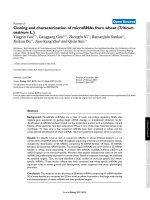
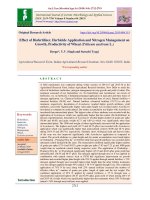


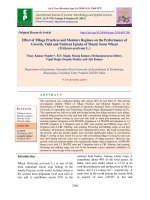
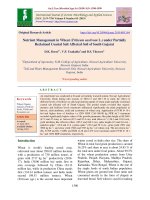
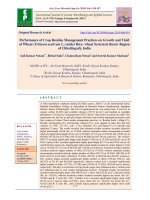
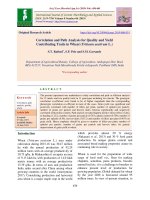
![Effect of different nitrogen levels and plant geometry on yield and nutrient uptake by brown top millet [Brachiaria ramosa (L.)]](https://media.store123doc.com/images/document/2020_01/14/medium_oyn1578935731.jpg)
